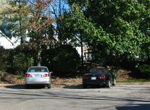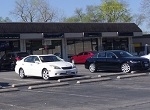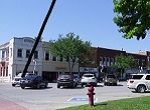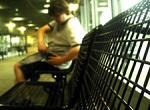How to Tame Big Box Stores
If You Can't Ban Them
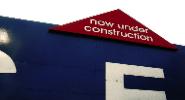
Last Updated: June 24, 2025
Large retail stores, known as big box stores, superstores, and "category killers" as well, have multiplied over the landscape and now can be found in most suburbs, small cities, towns, and increasingly in the heart of major cities.
Characteristically, these buildings vary from 50,000 to 200,000 square feet, but are truly big boxes because often they are rectangular cubes 30 feet tall or higher, even though operating as one story.
We won't name the brands, but they are the discount stores, warehouse clubs, or large electronics, home furnishings, or toy stores.
The box analogy also holds true in that there are few if any floor-to-ceiling internal partitions, no windows, and only the necessary doors. They aren't impeded by any architectural details, unless it's a large boxy surround for the front door, or what amounts to a gigantic sign built into the structure. These rectangular structures typically are surrounded by very large parking lots that have little relationship with any pedestrian or bike access, or for that matter, with stores on a small lot next door.
In spite of the fact that the term big box stores, which tellingly we are using in our title, usually is considered a negative term, many of neighbors think the low prices and large selections aren't necessarily a bad idea.
Most communities are tempted to roll out the red carpet for these stores, which provide good prices, the illusion or reality of progress for the community, and much-needed jobs.
But the most important disadvantage of these stores is that they compete with mom and pop businesses, and distinctive small shops, and often eventually drive them out of business because the larger chains can obtain volume discounts and pass on lower prices to the customer. Giant stores kill foot traffic, which is key to the success of locally owned business.
These large chain stores can devastate historic downtowns and cause families to lose businesses they have owned for several generations. While the job creation benefits look attractive, especially when unemployment or under-employment is rampant, the jobs frequently pay close to the minimum wage, offer only part-time hours, and include few or no benefits.
Another important point is that the return to capital benefits owners who don't live in your community. For more on this subject, see our pages on economic development and especially the theory of economic base.
A confounding factor is that these big box stores have started to group themselves together in what is called a power center. The store buildings may be attached or detached, but share road entrances and parking. If you think one big box store is bad architecture, consider three or four grouped together awkwardly amid surface parking.
Volume purchasing power is an understandable factor in being able to offer a low price, and the local mom and pop stores simply won't be able to compete on the basis of price any more. That's an economic problem and one that the clever retailer will have to figure out for himself or herself. A website about communities won't be able to offer much help there, although you can see the retail attraction, streetscape, and downtown redevelopment pages for more about how to create attractive retail districts.
But cities and towns that appreciate good urban design principles and place making will find much to fault in the typical big box layout, as described above.
However, our experience as planners has been that big box stores will upgrade their architectural approach when the local government stands firm on the basis of already existing standards. If their market research on your particular location indicates high potential, you can force some design concessions.
Softening the Design Issues with Big Box Stores
Below we are listing some requirements that we have used, or seen our colleagues in nearby cities use, to combat the big box store look.
1. Require some architectural detail. Specifically, require what the architects call articulation. On a building of more than 20,000 square feet, just to be on the safe side, you'll need some protrusions and recesses. You'll need some pattern other than just a uniform surface of fake stucco, and that should be approved by the planning commission or other design review commission.
2. Consider outlawing flat roofs and requiring some roofing pitch and detail as well. Since your old downtown and many of your existing smaller businesses may have flat roofs, depending on local custom, be careful how you word this. We are simply pointing out that flat roofs accentuate the boxy look in our opinion.
3. Require windows, not just in the front doors, but throughout each side of the building (each side would be called a "building elevation.") Require the windows to be in scale with the store, so the largest of the big box retailers would require the largest windows.
Yes, if they insist, you can group some of the window requirements at the front of the store, but make the windows go to nearly the top of the building then. The result would be a glass front, if you will, but then require some curved glass or at least the patterns of recesses and protrusions as described above. Glass also can be just as boring as sheet metal if a huge expanse if installed as a flat plane.
4. Natural materials including brick, stone, wood, and glass should be encouraged or required. Discourage that fake stuff.
5. It's perfectly appropriate to limit the size of each store within your zoning ordinance. If no store can be more than 50,000 or 80,000 square feet, you have a fighting chance to avoid an enormous white elephant when the big box stores leaves, as is typical, within 10 or 15 years.
Most are built to last just a few years, you may be surprised to know, but you as a community are going to be left holding the big box. If you're going to limit size, have an open debate about which chains you likely are excluding.
6. Require parking areas to be broken into sections with landscaping and with rain gardens that help detain the stormwater runoff and filter out pollutants. Impose a maximum square footage of parking that can be grouped together without a landscaped median or island, but be careful lest some puny little strip of grass be able to satisfy your requirement.
Experiment with requiring big box stores that are in or near historic downtowns to place their parking in the rear of the building rather than in front. Suburbanites may resist parking behind the store instead of near the street, but they will adjust. This one change could result in a more or less consistent setback from the street, which is very pleasing to the eye. It will not entirely compensate for the large mass in comparison with other stores nearby, but it will be a step in the right direction.
If the store is large enough, you may be able to require a parking garage, which is equally ugly but at least makes less of an impervious surface footprint. We are now seeing some parking garages with metal grid or metal pattern exteriors that actually are almost attractive. If sub-surface parking is practical in your geology, that's an even better solution.
7. Entryways should be obvious, but signs should be as small and tasteful as practical. In other words, design needs to carry part of the burden of directing people to the front of the store.
8. Require that safe pedestrian connections from the street into the store be designated and clearly marked. Bicycle connections also need to be specified, obvious, and separated from vehicular lanes.
If that seems like a real stretch to you because you already have a long strip of big box stores, maybe you need a coherent bicycle and pedestrian plan for the whole strip or district, instead of imposing a new regulation on the next big box stores that come your way.
9. The front setback for the store should be minimized to be consistent with other front setbacks in that area. The residential technique of simply averaging the existing front setbacks might give an odd result in this situation, but perhaps that could serve as a starting point that could be appealed by either the government or the big box store.
If people really want those low prices, won't they park on the sides of the building or in the rear? If you have parking in those locations, though, attention to wayfinding to the entries needs to be equally impactful on the sides and rear.
10. Landscaping at the street definitely should be required, and a portion of the landscaping needs to be scaled to fit the building. For instance, we are saying that if you have a typical big box store with a large parking lot in front of it, you would need both some taller trees to remain at least somewhat in scale with the building and some low shrubbery to try to make the environment as pleasant as possible for the pedestrian. It's also reasonable to require some benches and other amenities that people would find in a downtown near the street. After all, if you've made the big box store reasonably attractive to pedestrians and cyclists by giving them a dedicated, automobile-free entry path, they need a streetscape.
11. You could improve design by requiring the building to give the appearance of two stories, whether or not the interior is finished in that fashion. In other words, you can require second-story windows, or even awnings and things that you would find in a downtown area. Of course, even better is a true two-story retail operation, which can be achieved rather easily with escalators and elevators.
12. Big box stores actually can be combined with other uses, including smaller retail on the second floor, or adjoining apartment buildings. Part of the objection to big box stores is their profile as activity centers only during certain days and times.
So just like a downtown, the more you can enliven the area with 24-hour activity, the less the big box retailer will detract from a sense of place.
13. Some municipalities have experimented with vacancy restrictions, which require the original applicant to occupy the building for a particular period of time, or assist with finding a new tenant. This is a half-measure in my book, because regardless of the period of time, it probably would be too little. It's more worthwhile to require substantial materials, including brick, wood, and glass.
14. However, it's very worthwhile to investigate with your building code official whether there are ways to assure that the building can be retrofitted to have a true second story, or if it’s tall enough, a second and third story, in an economical manner.
Although we haven't noticed that it's been done, this would be an important concession for the community to achieve, because it would increase the likelihood that an empty large retail establishment can be refurbished reasonably into offices. This would work best if you have remembered our advice about plentiful windows.
Be Proactive About the Appearance of Commercial Buildings
Now these 14 design regulations are some tough stuff, and I bet some of your current zoning and other development regulations don't allow you to impose those conditions. You'll be left bargaining, and maybe with a high-priced corporate lawyer threatening you while you do.
So the time to think about what happens when you have an application for a big box store is now. This situation, if not others, should make you think of adopting guidelines to enforce sound urban design principles, an architectural review board, or a form-based code.
It will be difficult, although not impossible, to incorporate all 14 of these principles into your zoning code. And obviously, we haven’t covered every absurdity that these folks can invent either.
So take a deep breath and get prepared. If you already have a big box or many big boxes, think about what would be fair going forward. Don't take too drastic a step, lest you be sued successfully on the grounds that you allowed all these other brands to build. But do your research about what you have, what you should have, and what is permissible.
If you think you've allowed so many precedents that regulation will be difficult to defend, try the opposite approach, which is incentive zoning.
Think of what you can give them in return for their positive changes to their standard design. That may not work, but it’s worth a look. Remember that when your market is strong, you can get by with more regulation. In a weaker market or a situation where your jurisdiction is losing out to adjacent cities, it may be tougher to make the right decision. But the future of your city depends in part of whether you can stay firm about protecting your city's appearance.
Do something, and do it now, before you have more ugly big box stores on your hands.
More Food for Thought Relevant to Suburban Style Retail
- Making and Keeping a Good Community >
- Beautification > Big Box Stores
Join GOOD COMMUNITY PLUS, which provides you monthly with short features or tips about timely topics for neighborhoods, towns and cities, community organizations, and rural or small town environments. Unsubscribe any time. Give it a try.
